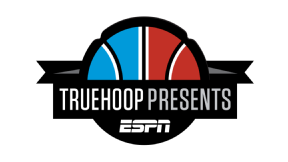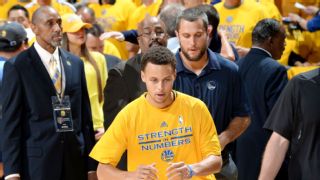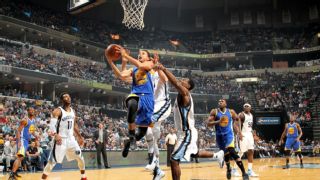|
This story appears in ESPN The Magazine's Feb. 29 NBA Body Analytics Issue. Subscribe today!  STEPHEN CURRY DIDN'T know if he'd wake up owning a dead man's tendons. STEPHEN CURRY DIDN'T know if he'd wake up owning a dead man's tendons.
It was April 25, 2012, and inside the Southern California Orthopedic Institute in Van Nuys, a renowned surgeon hovered over a baby-faced, decreasingly conscious Curry. In the vast majority of the ankles operated on by Dr. Richard Ferkel, who's cut thousands of holes into hundreds of NBA players since 1983, he knew precisely what he'd find well before the anesthesia started pumping -- structural damage, scar tissue, etc. But here in this fourth-floor operating room, something wasn't adding up with his 185-pound patient. As the clock ticked and the Curry family prayed just down the hall, Steph went to sleep a mystery. Before the drugs hit, Ferkel had explained a range of potential outcomes. Less than a year before, in Curry's hometown of Charlotte, North Carolina, a specialist had already sliced open that same right ankle and rebuilt two ligaments that had stretched apart like a rotting sweater. The worst-case scenario now? Total re-reconstruction, meaning that everything rebuilt in Curry's first surgery would be reattempted. If that proved necessary, they'd use better parts -- specifically, tendons from a cadaver -- and the projected recovery time would be at least six months. But such an operation would also be extreme enough that no one would be sure how the new hinge would hold up on the court. One near certainty: With Curry's rookie deal expiring in six months, on Nov. 1, 2012, his future with Golden State would be that much hazier. His agent would likely need to negotiate an extension before the undead ankle could appear in a game. Understand: The four doctors and two nurses in the operating room didn't know they were endeavoring to save the future of the NBA. Nobody, anywhere, considered that a 24-year-old who was still getting carded at California Pizza Kitchen was the impending nightmare of both LeBron James and Kevin Durant. At this point, Curry's trajectory was just depressing: In his first NBA season after the original procedure, he suffered five ankle sprains while playing in a mere 26 games.  "He was turning his ankle in completely nontraditional, crazy ways," Warriors general manager Bob Myers says. One time, Curry turned it while hopping into a passing lane during a preseason game against the Lakers. Another time, he was dribbling upcourt against the Spurs, with no one around, only to have his right foot fishtail like an old tire on black ice. "It was scary," Myers says. "I'd never seen someone sprain his ankle like that prior to Steph. And I haven't seen it since." The league had once envisioned Curry as a sharpshooter with a close-up magician's gift of misdirection. But now, as the Warriors guard rested atop Ferkel's operating table, his career resembled a crossover in reverse: a case of ankles breaking a man. "People started saying, 'Steph's got glass ankles. Steph's Grant Hill 2.0,'" recalls Bryant Barr, Curry's best friend and college teammate at Davidson. "He didn't hide his emotions, his frustration, for anyone." In college, somehow, Curry had no history of right ankle trouble. As a pro? The sight of the guy chucking his mouth guard, punching a padded chair or slapping the floor in existential agony became more memorable than any highlight. When Curry eventually blacked out on the operating table, however, a rather remarkable thing happened. A recent battery of strength tests, nerve tests, X-rays, MRIs and CAT scans had all failed to resolve why his ankle kept buckling. But a set of stress X-rays conducted midsleep, when pain can't impact motion, formally ruled out any structural damage to the ligaments. A 1-ounce HD camera snaked into Curry's subtalar and ankle joints produced images of thick, sticky bands of scar tissue -- "like crab meat," Ferkel says -- as well as inflamed tissue, bone spurs and chips of cartilage. To anyone else, orthopedic seafood might be revolting. To Curry, "it was good news," he says. "The least intrusive outcome." A motorized device called a shaver scraped and vacuumed all of it away in less than 90 minutes. No zombie tendons necessary. Projected recovery time: three to four months. Easier said than done, of course. Three months later, in July 2012, Curry was rehabbing with his personal trainer, Brandon Payne, when he made a startling confession: "I feel like I've been doing nothing but rehabbing for two years," Curry quietly told him. "I feel like I'm never going to be able to play again." He looked exceptionally miserable. And everyone could see it. "Steph was sick and tired of it," Myers recalls. "He said, 'This ankle thing is not gonna be my life.'"  IT'S NEARING MIDNIGHT in downtown Atlanta, and inside the players' lounge at an eerily empty Philips Arena, Keke Lyles is rotating his hips while grabbing his butt with both hands. Lyles has 24-hour entree to this room as the Hawks' new executive director of player performance, overseeing all medical, rehab and strength and conditioning decisions. The bearded 31-year-old received such an imposing title, which came with the power to handpick his own staff, in order to lure him away from his previous employer, Golden State. Or, as LeBron James described the title-winning, scratch-resistant team in November, "The most healthy team I've ever seen in NBA history." Before joining the Warriors as performance director in 2013, Lyles had been watching Curry from afar in Minnesota, where he was the Timberwolves' strength and conditioning coach. For all of the rehab hopelessness in July 2012, Curry would proceed to play a reassuring 78 games that season with a breakout 22.9/4.0/6.9 line. Ferkel's surgery, though, was no miracle cure. "You could see when Steph didn't trust his ankle," says forward Brandon Rush, who was on that 2012-13 team. "He didn't try to make the moves he usually makes. He didn't finish and take contact like he usually takes." Curry missed four games in January 2013 with right ankle sprains, exited one March game early for the same reason and -- worst of all -- rolled his left ankle during both Warriors playoff series, hobbling him against the Nuggets and then the Spurs. So Lyles arrived in Oakland with a new theory. At first blush, the Northeastern grad can seem like a bro-ish ex-athlete -- which, having grown up in Southern California, Lyles technically is. But in his junior year of high school, a life spent hooping was disrupted by a condition called femoroacetabular impingement, wherein extra bone growth causes excruciating pain in the hip. That part of the body is what turned his fascination inward, Lyles says, toward a career spent obsessing over how to fix athletes. And it is the same part of the body that would spring to mind, years later, when Lyles faced his first and foremost assignment with Golden State. Hence the pedagogical clutching of his derriere. Curry, Lyles believed, was already among the best in the world at changing direction. But the guard overwhelmingly relied on his ankles for speed and quickness. Those body parts appeared to be basketball's take on the mythical wings of Icarus: melting, as if made of wax, from overuse and ambition. But what if Curry could add another way to fly? "Shiftiness is an ankle strategy," Lyles explains, "but power comes from the hips. We wanted to teach Steph how to load his hips to help unload his ankles." Curry, haunted by what-ifs after those 2013 playoff sprains -- "I had to do rehab in between games; it brought back memories," he recalls -- was immediately sold on the theory. The best marksman in NBA history, perhaps unsurprisingly, turned out to be a quick study at exercise technique. "Steph's central nervous system is the best I've worked with," Lyles says. "It's why he's a great golfer, a great bowler, a great shooter." Curry swiftly perfected a yoga pose called the single-leg hip airplane, designed to build balance and core strength. He conquered the hip hinge, the fundamental movement of explosive lower-body exercises, in 10 minutes. He even mastered textbook trap-bar dead lifts, which amplify glutes and hamstrings, during his introductory session with Lyles. Other players typically need a week. At first, a willowy Curry could deadlift a pitiable 200 to 225 pounds. But then the labor began: less a Rocky training montage, heaving with theatrical workouts, than a time-lapse video, comically dense with, well, time. "The man was always in the gym," teammate Klay Thompson says. "Steph just stuck with the routine. He works on his body just as much as he works on his jump shot." By Curry's second year in the program, his dead lifts could touch 400 pounds -- more than twice his bodyweight and second most on the Warriors behind 6-foot-11, 265-pound center Festus Ezeli. "Steph became more aware of how he needs to take care of his body," says his father, Dell Curry, a 16-year NBA vet. "It helped him understand that his body is his career."  The objective is never bulk; Steph prefers his weight at no more than a chiseled 190 pounds. Instead, both Lyles and Payne -- to whom Curry still entrusts his ankles in the summer -- harp on stability amid a storm of jumps, hard cuts and pick-and-rolls. For that same reason, some 90 percent of Curry's lower-body strength work with Payne is one-legged: single-leg reverse lunges, rear-foot elevated single-leg squats, single-leg dead lifts. A standard offseason warm-up involves standing like a flamingo on a squishy blue Airex pad as Payne obscures Curry's vision, sometimes with flashing strobe goggles, and whips basketballs his way. "Steph's core strength," Payne declares, "is second to none." In each of the past two seasons, Curry has careened into the paint -- a forest of lower-leg dangers -- and shot more often and at a better percentage than all but seven players, all of them bigger. No one is better than Curry at misdirection through hip gyration, as when he thrice juked Kawhi Leonard on Jan. 25 before hitting a corner 3, transfiguring the defensive player of the year into a viral chalk outline. And yet that play might not have been more impressive than one seven days earlier, when Curry found himself the meat in a Kyrie Irving-LeBron James sandwich in the lane. He judo-tossed the 250-pound James onto the floor, broke free of Irving's grip, sprinted past a screen and drained a 3 in the time it took for James to stand back up. "The way Steph moves, 98 percent of the world would hurt themselves trying to run like that," says Warriors assistant GM Kirk Lacob, son of owner Joe. "I think people would pay to watch Steph work out." Watching the 27-year-old stay on the court has been gift enough. Over the past two and a half seasons -- a run of three All-Star selections, a 2014 FIBA World Cup gold medal, 28 NBA playoff games and one title (so far) -- Curry has missed a measly two games due to ankle-related concerns. The first came in November 2013, as a precaution for a left ankle bone bruise. The second was in February 2015, after his right foot landed on Boris Diaw's left. And that's it. A theory appears to have paid off. But here in Atlanta's lounge, Lyles takes care to philosophize about the boundless constellation of factors that compose any injury equation. He brings up Curry's pair of Zamst ankle braces, worn every game. And Curry's pair of Under Armour sneakers, scientifically designed for his feet. And the insight into fatigue that the Warriors have gleaned from analyzing player-worn GPS accelerometers in practice and the overhead SportVU cameras in arenas. And coach Steve Kerr's sincere commitment to improving health by reducing personal stress. (On training days, Lyles would intermittently send Curry off to unwind with his family or play golf with swingman Andre Iguodala.) Then there's the Warriors' roster, which is so good and so deep that Curry, through 50 games, was averaging just 33.8 minutes a game (32nd in the NBA), shrinking risk exposure. Last year he averaged 32.7 (41st). "All of that matters," Lyles says. "I could argue that everything matters." Which means, logically, that any random thing can also be a threat.  IT'S HALF AN hour before Golden State hosts Miami in January, and Bob Myers and Kirk Lacob sit around a circular table in a small back room underneath Oracle Arena, mulling over Curry's ankles. As much as any front office in sports -- owing at least partly to its proximity to Silicon Valley -- Golden State's front office actively quantifies injury risk. Yes, Myers and Lacob agree, any random threat might matter. "But the aspiration is to measure as much as we can," Myers says. The Warriors hired their new head of physical performance and sports medicine, Australian sports science expert Lachland Penfold, with this data-driven mission in mind. "Eventually," Lacob says, "we'll have, like, a video game fatigue meter. A guy like Lachland will be able to go up to Bob and Steve [Kerr] and say, 'Guys, he's at a 77, and our threshold is 75 for Safe to Play.'" (The team declined to make Penfold available for an interview.) Obviously, when it came to re-signing Curry before Nov. 1, 2012, there was nothing close to such technology. Asked now about the thinking behind his approach, Myers chuckles like a trader who bought Google mid-recession. "I wish we could've paid Steph more," he says with a grin. But the GM notes that at the time of the outlay -- a four-year, $44 million extension -- Curry had just sprained his right ankle in the preseason, labeling him rather emphatically Unsafe. "So we decided to bet on a couple of things," Myers explains. "We bet on who he is as a human being. We bet on his ability. We bet on the fact that he was the type of player who'd do everything within his power to come back and be smart and be diligent." But to be perfectly clear: "Nobody could imagine this happening," Curry says. It was unthinkable that the Warriors might one day offer the theory currently being advanced inside this back room: A Steph Curry who has never injured his ankles would be less preferable than the Steph Curry we actually have today. "The ankle thing made him work smarter, to counteract him ever being put in that position again," Lacob says. "If he hadn't had it, maybe he wouldn't have the same core strength." Adds Myers, nodding, "It made Steph what he is now." This is not to suggest that the people in Curry's inner circle have stopped worrying about him. Five separate interviewees knock on wood in the middle of talking about his ankles. One of them, Warriors assistant coach Bruce Fraser, who oversees Curry's famed pregame shooting routine, frets about defenders challenging Curry's jumpers by getting underneath him, turning their feet into land mines. "But I don't know if Steph's aware of that," Fraser says. "And I don't know if I want to make him think about it." Ferkel, meanwhile, still pays periodic visits to the Bay Area, just to check in. And Payne still can't shake the feeling of watching Curry limp after hitting his banged-up left shin against Lakers center Roy Hibbert in January. "It scared the hell out of me," the trainer says. "It brought back immediate memories of Steph getting hurt." Payne sighs, then continues: "Watching him isn't the enjoyable process you'd think. It's a lot of sitting on edge." Dell sometimes declines to sit altogether. This Christmas, in the middle of the second quarter of the Cavs game at Oracle, Steph had to go back to the locker room to attend to a right calf strain. It was exactly the type of scene that leads to naysayers crowing about injury luck regressing to the mean ... and friends texting Lyles in Atlanta, half joking, How long until your phone rings ... and a terrified dad suddenly abandoning his chair to follow his son inside. "Any time I'm at the game and Steph gets dinged up," Dell says, a tad sheepishly, "I'm able to get around that building pretty good. Just to see what's going on." It is even more remarkable, then, that the player in question might be less anxious than them all. Back in the Warriors' locker room after trouncing the Heat by 15 -- Steph dropped a ho-hum 31 -- Curry ponders his front office's theory of his evolution. After all that agony and uncertainty, does he honestly believe that the absurdity of his ankle history has saved him from a worse career? "I think so," Curry matter-of-factly replies. "It definitely drove home my work ethic. Post-surgery, it's kept me driven about taking advantage of every day. There was a time when I was just worried about playing basketball, much less playing at a high level. Now I try to have as much fun out there as possible. You don't enjoy the surgery and the rehab process. But I enjoy how I came out of it, for sure." His answer carries the rosy whiff of cliché, admittedly. But when you remember all that must be waved aside to embrace this unfinished timeline of events, so much positivity sounds less like optimism and more like the real secret to Steph Curry's flying, higher than ever. He learned to forget, finally, that he still might fall.
|

